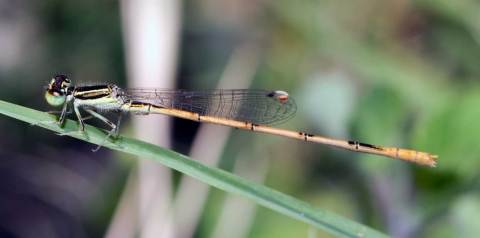Some insects look so delicate and fragile that it’s hard to remember that they can be among the most ferocious predators, at least for their size, on the planet. Case in point: the tiny little yellow damselfly Ischnura hastata, commonly known as the Citrine Forktail. It’s only about an inch long and its wings look so delicate and flimsy it’s a wonder that it can fly at all:
But the damselfly, like its larger cousin the dragonfly, is a voracious predator both as larva and imago (adult). According to the most recent (and best) field guide published on odonates of the eastern United States,
Odonates are all predators, in both adult and larval stages…
Most dragonflies take small prey, much smaller than themselves. Tiny flies, leafhoppers, and beetles are common prey. Some species vary these with larger prey, for example other dragonflies and butterflies, and others seem to be specialists on large prey… [S]ome pond damsels will take another damselfly of the same size, especially when the latter has just emerged and is quite vulnerable. Note that dragonflies that routinely take large prey are among the most effective biters when captured!
[Paulson 2011]
I’ve never been bothered by biting dragonflies or damselflies, but then, I’ve not yet invested in an insect net to capture any, either, so perhaps I should just leave that alone. My preferred mode of capturing insects is via my camera’s imaging chip.
There have been relative hordes of damsels in the front and back yards lately; I suppose that means spring has sprung. Cheers!
Oops! Almost forgot the etymology.
It took some searching, but this Italian paper finally gave me the origin of the genus name Ischnura:
Ischnura – ισχηοσ = gracile + ουρα, ασ = coda; dalla coda gracile. Per la forma esile
dell’addome.
My Italian is a mite rusty, but it looks like it means “from the gracile [a hifalutin English word meaning slender] tail. For the slender form of the abdomen.”
As for the species name hastata, that presumably comes from the Latin hasta, “spear.” So this tiny little damselfly’s taxonomic name basically translates to “slender spear.”
Say’s original genus name for this species was Agrion, which presumably came from Greek agrios, wild. So “wild spear” was what he had in mind when naming this species, which later came under the older genus name, Ischnura.

